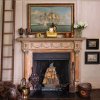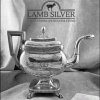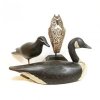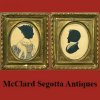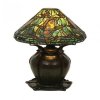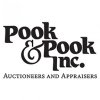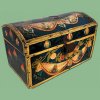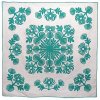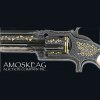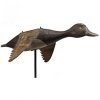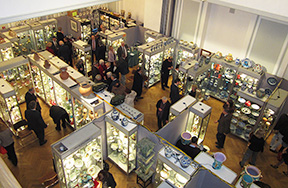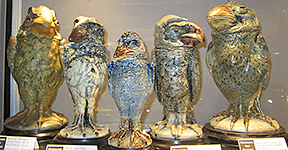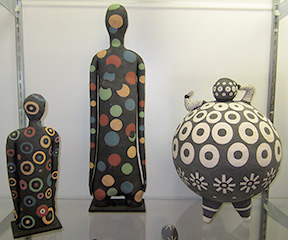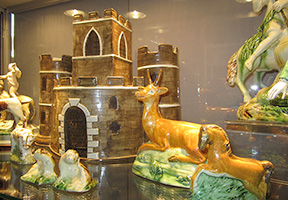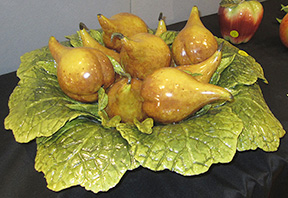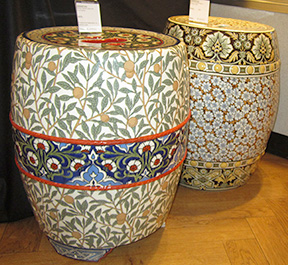Ceramics Fair 2013
January 22nd, 2013
|
The Bohemian National Hall is a perfect place for the New York Ceramics Fair.
A chorus of Martin Brothers bird tobacco jars were (from left) $50,000, $35,000, $32,000, $90,000, and $55,000 from George Kingham of Kinghams Art Pottery, Ltd, Gloucestershire, in the Cotswolds, U.K. One sold! The second from the right is wearing a barrister’s wig. Kingham said a year ago he got a quarter of a million pounds, a record price, for two Martin Brothers tobacco jars depicting Gladstone and Disraeli. 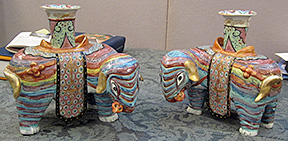 Paul Vandekar of Earle D. Vandekar of Knightsbridge Inc., New York City, asked $18,000 for these Chinese export porcelain elephant candlesticks, and they sold.
Ceramics by Jose Arias, (from left) $5500, $3500, and $2200, from Martin Cohen, who sold more than half a dozen pieces of his pottery.
John Howard of Woodstock, Oxfordshire, U.K. asked $5500 for this pearlware castle, perfect for toy soldiers or as a table centerpiece.
Katherine Houston of Boston asked $7000 for these porcelain pears, a centerpiece. She said she sold well. She has a following, having showed at the New York Ceramics Fair for nine years.
Two Minton garden seats were $2400 and $3000 from Carmen Pattinson of Cheshire, England. |
New York Ceramics Fair, New York City
For the 14th year the New York Ceramics Fair, held January 22-27, was the first show to open during Americana Week in New York City. On Tuesday evening, January 22, those who arrived promptly at 5 p.m. had plenty of time to see the 30 dealers before going off to other events. (The members’ preview of the William Matthew Prior exhibition at the American Folk Art Museum was one.) The opening night crowd was the largest in several years; 729 tickets were sold. It was impossible to get into London dealer Garry Atkins’s stand; customers lined up, picked out what they wanted, and promised to come back to pay and pick up later in the week. They did.
Wednesday and Thursday were slower, but on the weekend the crowd picked up, and so did sales. Walt Borton, the public relations pro for the fair, reported that the total gate was close to pre-recession levels.
This show is not about crowds as much as it is about making discoveries and exchanging information. Who had ever seen a piece of Isleworth porcelain before? Not many. Roderick Jellicoe of London had identified this small English porcelain factory in 1998, and when the Bartlam bowls turned up in London they were called Isleworth for a few years before Jellicoe identified them as Bartlam, noting that their blue transfer designs matched shards excavated at Cain Hoy, South Carolina. At the fair, Jellicoe offered a genuine Isleworth leaf-shaped dish with a transfer-printed gillyflower pattern for a fraction of the price of a Bartlam bowl.
And who knew that Portuguese tin-glazed wares were used in Jamestown, Virginia? Those who attended Rob Hunter’s lecture on “Ceramic Collecting in the 21st Century” on Saturday learned that. Garry Atkins offered five Portuguese blue and white chargers, and he sold four, two to museums.
The fair is for collectors, especially those who collect English pottery. Collectors left the stand of English dealer John Howard with bags full of English creamware or directed him to ship it. London dealer Martyn Edgell sold a rare Ralph Wood figure of Benjamin Franklin to dealer Rex Stark of Gardner, Massachusetts, at the preview. Edgell sold Pratt- ware and creamware too. Dutch dealer Léon-Paul van Geenen sold Delft and glass. Collectors of 19th-century English pottery, porcelain, and majolica had plenty to choose from, and the dealers said they sold well. Marcia Moylan and Jackie Smelkinson of The Spare Room, Baltimore, Maryland, specialize in English wares in Imari colors, and they said they sold more this year than last year to collectors and to the decorating trade. Nicolaus Boston of Limerick, Ireland returned after being absent for several years, and his Aesthetic Movement wares and majolica were well received as were the wares of two dealers new to the show from the U.K. George Kingham, a specialist in art pottery, sold a Martin Brothers bird jar that was illustrated on the back cover of the show catalog and some contemporary wares from the Dennis pottery that had not been seen in New York before. Carmen Pattinson offered English majolica and European ceramics, 1850-1950, that included a case full of Art Deco. Pattinson’s Lenci porcelain figures caused a great deal of comment. Pattinson sold a Minton vase to a museum and is looking forward to returning next year. Sarah Eigen, a private dealer in New York City, specializing in Aesthetic Movement decorative Wedgwood, Minton, Doulton, and Copeland, said she sold very well.
London dealer Sylvia Powell sells limited-edition works by Picasso and Cocteau, along with works by English makers William De Morgan and William Moorcroft, and has a large following. Mark J. West had a shelf full of glasswares to be picked up on Sunday, and said he had already delivered ten pieces from the Val Saint Lambert glassworks in Belgium. Ian Simmonds, who has moved to Carlisle, Pennsylvania, to become a full-time dealer in American glass, said he had a very good show, but Gary Stradling, who shared a booth with Simmonds, said that business was slower than last year for him. John Suval said he had the best fair of the last couple of years selling Chinese export porcelain. Santos from London said he had only one significant sale, a rare Chinese export Famille Rose plate with a figure of Don Quixote and his servant Sancho Panza, circa 1750.
Michelle Erickson of Yorktown, Virginia, brought some of the works she made during her three-month residency at the Victoria & Albert Museum in London last summer. She put in her case a pair of Nike Olympic trainers from which she adapted a sole pattern that she applied in three Olympic rings to salt-glazed stoneware. Erickson has rediscovered lost ceramics techniques, so she is able to reproduce the 18th-century bodies and decoration. She showed a pecten-shaped agate teapot she made, a porcelain skull with a gas pump from her “Fossil Fuel” series, and plates decorated with x-ray-like parts of skeletons, adapting an old Staffordshire slipware tradition for her so-called “Potter’s Field” series. Her work is a comment on the human experience and on social, political, and environmental issues.
Leslie Ferrin, a dealer in contemporary ceramics in Pittsfield, Massachusetts, has created a project she calls COVET, a collection of works by artists that use historical sources in museums. Many of them, inspired by Erickson, also comment on social and political issues.
Martin Cohen of Great Neck, New York, said he sold nine sculptural ceramics by Jose Arias. Ceramicist Katherine Houston of Boston sold her largest and most elaborate centerpiece of artichokes and vegetables. As did Houston, ceramicist R.A. Pesce of New York City sold his own works. It was his first time at any fair, and he said he made a number of sales in the $200 to $500 price range.
There were at least two dozen museum curators at the fair, and they did some buying, especially from the ten dealers who came from across the pond. There was an upbeat mood as the dealers packed up and talked of returning next year. The Bohemian National Hall is perfect for a small show. Caskey Lees of Topanga, California, the show’s producers, are hoping that a few more dealers will participate as the market recovers.
The photographs feature more of what was available at the show. For more information, go to (www.caskeylees.com/NY_Ceramics/NY_Ceramics.html).
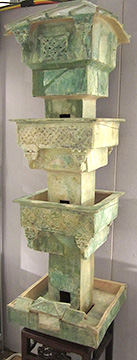 This massive (4' tall) Chinese green-glazed pottery model of a watchtower, Han Dynasty (206 B.C.-A.D. 220), was $38,000 from Vallin Galleries, Wilton, Connecticut. Peter Rosenberg of Vallin Galleries explained that it was interred in a tomb, probably with a general, who would have owned a real one in his lifetime. This massive (4' tall) Chinese green-glazed pottery model of a watchtower, Han Dynasty (206 B.C.-A.D. 220), was $38,000 from Vallin Galleries, Wilton, Connecticut. Peter Rosenberg of Vallin Galleries explained that it was interred in a tomb, probably with a general, who would have owned a real one in his lifetime. |
Originally published in the April 2013 issue of Maine Antique Digest. © 2013 Maine Antique Digest
